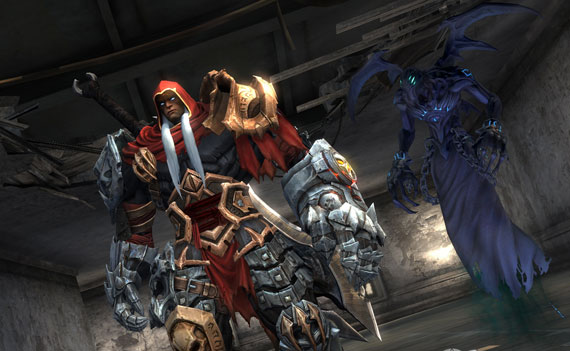To say that the combat in Darksiders is much like that of God of War and its dungeon design is a near-facsimile of modern Legend of Zelda games would be a fairly accurate description, but there is much more to this game than only simple analogies. Although very little is truly original about Darksiders, the final product carves out its own unique identity by successfully combining, and in many cases refining, the elements of all the works from which it borrows, and the amalgamation of gameplay mechanics in Vigil Games’ debut title is a near-perfect love letter to gaming enthusiasts.
Darksiders is a tale about War, one of the Four Horsemen of the Apocalypse, and on top of its mostly borrowed game design, it also takes creative license with the stories and characters found in Abrahamic mythology. In Darksiders, War’s goal is to serve the Charred Council and restore the balance between heaven and hell, at the same time exacting revenge on those who have prematurely ignited an earthly “Endwar” and set him up to take the fall for that treachery. The story is a bit hard to follow at first because it throws so many names and events at the player at once, so it is not unlikely that one will find him- or herself cluelessly wandering forward until more is revealed and key plot points are clarified. Then again, story is not the primary appeal of this game — it is all about gameplay: combat, character enhancement, puzzles, etc.

Darksiders features an excellent system by which War’s power builds over the course of his journey. Shopping with the demon Vulgrim unlocks new abilities and combat maneuvers as War progresses, defeating enemies and collecting their souls for use as currency. This makes combat an ever-complexifying and increasingly enjoyable aspect of the game, especially as new weapons are earned, doubling and tripling War’s attack options and turning battles into almost artistic exercises in stringing together as many different attacks as possible and vanquishing foes in efficient, yet stylish ways. A problem with going this route, however, is that in order to compound combat skills, the system must be overly simple to begin with… and it is. Early in the game, mashing the square button is just about the only option, aside from a single Wrath Power, and battling many of the same opponents feels a bit mundane. Unfortunately, in the explosive and action-packed opening scene, Vigil does not offer a glimpse at War’s full strength, so the player is never fully aware of what goodies to expect later on, even though what awaits is ultimately enjoyable angel- and demon-slaying.
For all of its high-energy combat, button-prompted kill animations, mythologically dark, yet colorful enemy design, dramatic cutscenes, huge bosses, and varied, hellish environments, all on an epic scale, Darksiders is not the God of War clone these aspects might suggest, particularly in its overall structure. Like Zelda games, Darksiders is organized into self-contained “dungeon” areas where War must navigate rooms and defeat enemies on his way to that location’s final guardian. In each of these unique, themed areas, War will find rooms that remain sealed until all enemies have been defeated, locked doors that are only passable after finding keys hidden elsewhere in treasure chests, and environmental puzzles ranging from connect-the-dots simplicity to genuine thought provocation and clever design. There are even maps and hoardseekers (like Zelda’s compass, these note the locations of treasures on the map) tucked away in more chests, and special items such as a boomerang blade and grappling chain (hookshot, to Zelda fans) to find within each dungeon. These areas, as well as the more central parts of the game world, feature open layouts that unfold and allow further access as play progresses and War acquires new items and abilities. And although the dungeon design occasionally lends itself to backtracking, for the most part the game leaves the player just where it should when a new way forward becomes accessible, successfully making his or her gamer-sense tingle with approval.

Darksiders, in blending these two well-established videogame formulas, improves upon some of the weaker components of each, but at the same time creates new and noticeable shortcomings of its own. In focusing so much on great core gameplay, Vigil has crafted a world that is arguably too light on non-player character interaction, but does not convey a sense of isolation or desperation, either. The result is that the game world simply feels depopulated — like it is missing something. It does reinforce the idea that this is purely a gamer’s game, but maybe the world would feel richer with something more than hordes of enemies and strongholds full of puzzles. Even the overwhelmingly satisfying combat has a few minor issues. Blocking enemy attacks is less fluid than one might hope; War must stand perfectly still in order to successfully block incoming blows, and he cannot cancel out of his own attacks to defend himself. And when it comes to finishing foes off, players will undoubtedly love the kill animations, but repeating the same motions with enemy after enemy loses its appeal. It would be nice if there were a little more variety than the one-animation-per-enemy-type thing Darksiders has going on.
In the end, any complaints about Vigil Games’ first outing are far outweighed by the reasons to praise it. If for no other reason than its ability to seamlessly fuse the best aspects of two great formulas, Darksiders is a triumph in game design, a platform to build upon (the ending hints at a sequel!), and something everyone who truly loves video games should try, because you’ll likely love it.

















